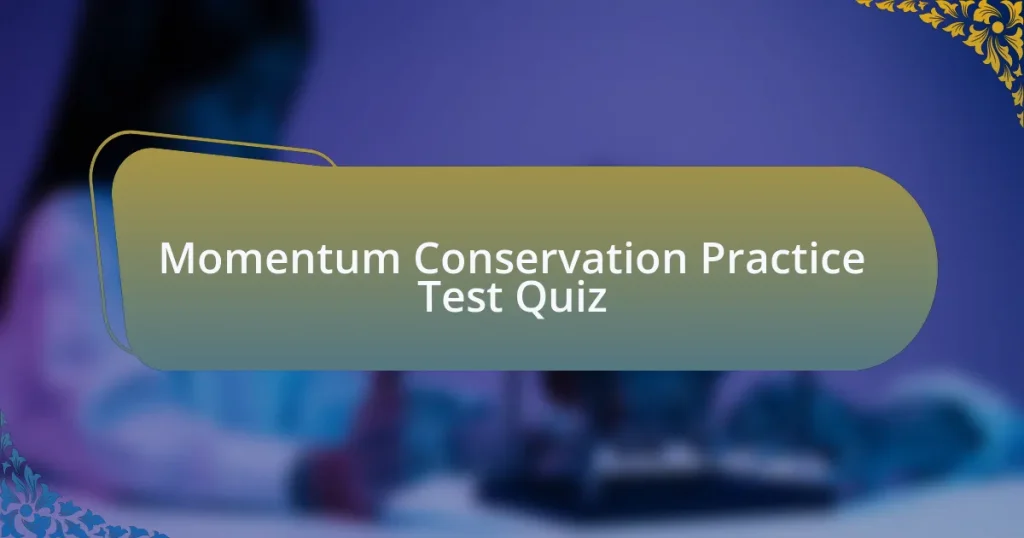Start of Momentum Conservation Practice Test Quiz
1. What is the principle behind the conservation of momentum in closed systems?
- The total force in a closed system remains constant.
- The total energy in a closed system remains constant.
- The total mass in a closed system remains constant.
- The total momentum in a closed system remains constant.
2. How does momentum behave during an elastic collision?
- Momentum is irrelevant in an elastic collision.
- The total momentum is lost in an elastic collision.
- Momentum can vary freely during an elastic collision.
- The total momentum is conserved in an elastic collision.
3. What is the formula to calculate momentum?
- \( p = m \times v \)
- \( p = m – v \)
- \( p = m + v \)
- \( p = m / v \)
4. In the event of a perfectly inelastic collision, what happens to the objects involved?
- The objects stick together and move with a common velocity.
- The objects bounce off each other completely.
- The objects break apart and lose mass.
- The objects separate and continue with their original velocities.
5. When two objects collide and stick together, how is their momentum distributed?
- The momentum is equally divided between the objects.
- The momentum is lost in the collision.
- Their momentum remains conserved.
- The momentum is doubled after the collision.
6. What occurs to kinetic energy in perfectly elastic collisions?
- It is halved.
- It is conserved.
- It is doubled.
- It is lost as heat.
7. What is the relationship between impulse and momentum change?
- Impulse is the opposite of momentum change.
- The impulse applied to an object equals its momentum change.
- Impulse is less than momentum change.
- Impulse is unrelated to momentum.
8. How do you define a perfectly inelastic collision?
- A perfectly inelastic collision occurs when kinetic energy is completely transformed into potential energy.
- A perfectly inelastic collision is defined as one where two objects stick together after colliding.
- A perfectly inelastic collision happens when two objects bounce off each other without sticking.
- A perfectly inelastic collision is when the total momentum is not conserved during the collision.
9. If two objects have the same mass and collide elastically, how is their velocity affected?
- They move in opposite directions.
- Their velocities remain the same.
- One object stops completely.
- Their velocities are exchanged.
10. What happens to the total momentum in a completely isolated system?
- The total momentum becomes zero.
- The total momentum remains constant.
- The total momentum increases without limit.
- The total momentum can be negative.
11. If a ball rebounds after hitting a wall, how is the impulse related to the change in momentum?
- The impulse is equal to the change in momentum.
- The impulse is the square of the change in momentum.
- The impulse is half the change in momentum.
- The impulse is unrelated to the change in momentum.
12. What unit is momentum measured in?
- N·s
- m/s
- kg·m/s
- J
13. How do you derive force from momentum in motion?
- \( F = m \times a \)
- \( F = \frac{p}{v} \)
- \( F = \frac{\Delta p}{\Delta t} \)
- \( F = p \times v \)
14. If a moving object collides with a stationary object, how is momentum conserved?
- Momentum changes direction and is not retained after the collision.
- Momentum is only conserved for the object that was originally moving.
- Momentum is destroyed when the two objects collide.
- Momentum is transferred from the first object to the second object during the collision.
15. In a collision, how can you find the final velocities based on initial momenta?
- Use conservation of momentum to set the total initial momentum equal to the total final momentum.
- Apply Newton`s second law directly without considering momentum.
- Use only the velocities of the objects to find final velocities.
- Ignore mass and only use initial speeds to determine outcomes.
16. What effect does an increase in mass have on momentum at a constant velocity?
- Momentum remains unchanged.
- Momentum becomes zero.
- Momentum decreases.
- Momentum increases.
17. How does the speed of an object influence its momentum?
- Momentum is independent of speed.
- Momentum decreases with speed.
- Momentum increases with speed.
- Speed does not affect momentum.
18. What must be true about the momentum of two colliding objects in elastic collisions?
- The total momentum before and after the collision is conserved.
- The momentum increases when the objects collide.
- The momentum decreases after the collision.
- The momentum remains constant for one object only.
19. In terms of momentum, what does the term `system` refer to?
- Any random objects in space.
- A single object in motion.
- A specific location in the universe.
- A collection of particles being analyzed for momentum.
20. How does the mass of an object influence its kinetic energy during a collision?
- The mass of an object affects its kinetic energy, as doubling the mass doubles the kinetic energy at constant velocity.
- Kinetic energy is solely determined by an object`s velocity, not its mass.
- The mass of an object does not influence its kinetic energy at all.
- Kinetic energy is inversely proportional to the mass of the object.
21. If two carts collide and stick together, what is the resulting speed if their initial speeds are equal?
- 5 m/s
- 15 m/s
- 0 m/s
- 10 m/s
22. What is the result of a collision in which one object has a significantly larger mass?
- Both objects stop moving after the collision.
- The larger object moves faster than the smaller one.
- The smaller object gains more mass after the collision.
- The smaller object gets pushed back and may not move much.
23. What happens to the velocity of a combined mass after a perfectly inelastic collision?
- The final velocity remains constant before and after.
- The final velocity is greater than the initial velocities.
- The final velocity becomes zero immediately after.
- The final velocity is less than the initial velocities.
24. How do you calculate the impulse experienced by an object during a collision?
- Impulse is determined by the weight of the object multiplied by distance.
- Impulse is equal to the total energy of the object after the collision.
- Impulse is the product of mass and velocity of the object.
- Impulse is calculated by multiplying force by the time duration of the impact.
25. If one object has double the velocity of another, how does that affect their momentum in a collision?
- The object with double the velocity has half the momentum.
- The object with double the velocity has double the momentum.
- The object with double the velocity has three times the momentum.
- The object with double the velocity has no effect on momentum.
26. When calculating momentum, what physical quantities do you need?
- Force and displacement
- Mass and velocity
- Energy and time
- Charge and resistance
27. In perfectly elastic collisions, how do post-collision velocities relate to pre-collision velocities?
- The post-collision velocities are always equal to each other.
- The velocities are related by conservation of momentum.
- The velocities rigidly depend on the mass of the objects.
- The velocities do not change after the collision.
28. What is the net momentum change for two objects in a completely elastic collision?
- The net momentum change is equal to the total mass.
- The net momentum change is zero.
- The net momentum change is positive.
- The net momentum change is negative.
29. In a scenario where two identical balls collide, what remains constant?
- Velocity
- Mass
- Momentum
- Kinetic Energy
30. How can you visually illustrate momentum conservation?
- Use a single ball bouncing on a surface.
- Use a collision simulation with two carts.
- Draw a static diagram of objects.
- Present a graph of speed over time.
Congratulations on Completing the Quiz!
Well done on finishing the Momentum Conservation Practice Test! You’ve taken a significant step in your Physics Test Preparation journey. This quiz has not only tested your knowledge but also helped solidify your understanding of key concepts related to momentum conservation. Concepts like elastic and inelastic collisions, along with impulse and change in momentum, are crucial in the study of physics.
Throughout the quiz, you likely discovered valuable insights. Perhaps you gained a greater appreciation for how momentum is always conserved in isolated systems. Understanding these principles is essential for tackling more complex physics problems in the future. Every question you answered contributes to your mastery of this fundamental topic.
If you’re eager to delve deeper into momentum conservation and further enhance your knowledge, we invite you to explore the next section on this page. It contains additional resources and explanations that can offer you a more comprehensive understanding. Let’s keep the momentum going as you continue your studies!
Momentum Conservation Practice Test
Understanding Momentum Conservation in Physics
Momentum conservation refers to the principle that the total momentum of a closed system remains constant over time. This law applies to both elastic and inelastic collisions, where no external forces act on the system. The formula for momentum, defined as the product of mass and velocity (p = mv), highlights its vector nature. As momentum is conserved, the momentum before a collision equals the momentum after the collision, providing a predictable outcome in physics problems.
Types of Momentum Conservation Problems
Momentum conservation problems can be categorized into two main types: one-dimensional and two-dimensional problems. One-dimensional problems involve collisions or interactions along a single line, making calculations straightforward. Two-dimensional problems involve interactions on a plane, adding complexity due to the need for vector analysis. Each problem requires applying conservation principles to calculate unknown quantities such as final velocities or masses.
Common Equations Used in Momentum Conservation Tests
Key equations in momentum conservation include the conservation of momentum formula and the impulse-momentum theorem. The conservation of momentum formula states that the total momentum before an event equals the total momentum after the event (m1v1 + m2v2 = m1v1′ + m2v2′). The impulse-momentum theorem links impulse (force multiplied by time) to the change in momentum, providing a basis for solving various momentum-related problems.
Tactics for Solving Momentum Conservation Practice Tests
Effective tactics for solving these tests include identifying the system, isolating objects involved in the collision, and carefully applying conservation laws. Start by drawing a simple diagram to visualize the problem. Determine known and unknown variables, and select the appropriate equations before solving step-by-step. Pay attention to units and ensure that momentum vectors are accounted for correctly, which avoids common mistakes in calculations.
Resources for Momentum Conservation Test Preparation
Preparation resources for momentum conservation tests include textbooks, online practice problems, and educational videos. Standard physics textbooks provide foundational knowledge and example problems. Online platforms often feature interactive quizzes that allow for immediate feedback. Educational videos can demonstrate problem-solving approaches, reinforcing understanding of concepts in real time.
What is a Momentum Conservation Practice Test?
A Momentum Conservation Practice Test is an assessment designed to evaluate a student’s understanding of the principle of momentum conservation in physics. This test typically includes problems that require students to apply the law of conservation of momentum to various scenarios, such as collisions and explosions. It serves to reinforce knowledge and problem-solving skills related to momentum, a critical concept in mechanics.
How can I prepare for a Momentum Conservation Practice Test?
To prepare for a Momentum Conservation Practice Test, students should review key concepts related to momentum, such as its definition, conservation laws, and equations. Practicing problems that involve calculating momentum before and after events like collisions is essential. Additionally, utilizing resources like textbooks, online videos, and practice problems can solidify understanding. Engaging in study groups or discussions can also enhance comprehension of challenging concepts.
Where can I find resources for a Momentum Conservation Practice Test?
Resources for a Momentum Conservation Practice Test can be found in physics textbooks, educational websites, and online learning platforms. Websites like Khan Academy, Physics Classroom, and educational YouTube channels offer explanations and practice problems. Additionally, school libraries may have reference materials, while teachers often provide practice tests. Peer-reviewed journals and academic articles may also include relevant problems for study.
When is a Momentum Conservation Practice Test typically administered?
A Momentum Conservation Practice Test is typically administered during a unit on mechanics in high school or introductory college physics courses. It often follows lessons on momentum, typically after students have had sufficient time to learn and practice the concepts. Specific testing periods can vary by school or instructor, usually aligned with exam schedules or after completing relevant coursework.
Who should take a Momentum Conservation Practice Test?
Students enrolled in physics courses, particularly those focusing on mechanics, should take a Momentum Conservation Practice Test. This includes high school students in AP Physics or introductory college courses. Additionally, students preparing for standardized tests in physics may find such practice tests beneficial for reinforcing their understanding of momentum concepts. It helps gauge readiness for both academic assessments and practical applications.















